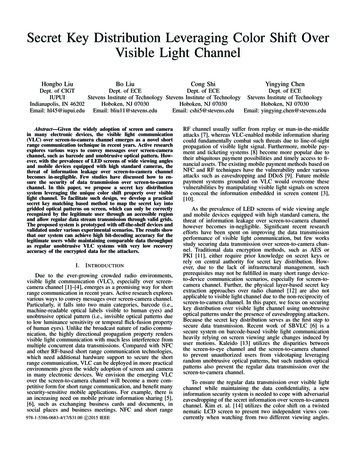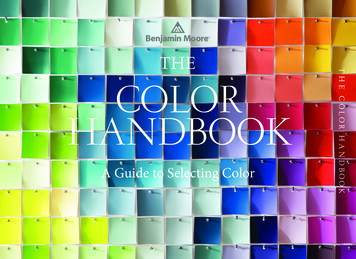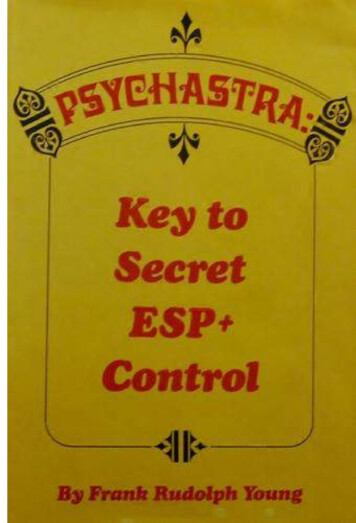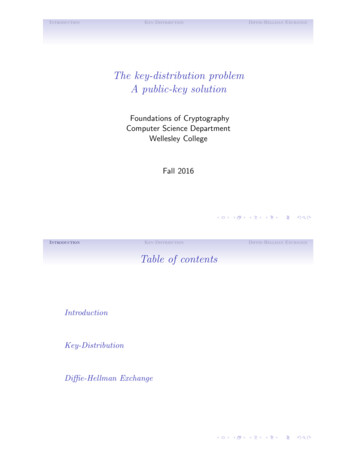
Transcription
Secret Key Distribution Leveraging Color Shift OverVisible Light ChannelHongbo LiuBo LiuCong ShiYingying ChenDept. of CIGTDept. of ECEDept. of ECEDept. of ECEIUPUIStevens Institute of Technology Stevens Institute of Technology Stevens Institute of TechnologyIndianapolis, IN 46202Hoboken, NJ 07030Hoboken, NJ 07030Hoboken, NJ 07030Email: hl45@iupui.edu Email: bliu11@stevens.eduEmail: cshi5@stevens.eduEmail: yingying.chen@stevens.eduAbstract—Given the widely adoption of screen and camerain many electronic devices, the visible light communication(VLC) over screen-to-camera channel emerges as a novel shortrange communication technique in recent years. Active researchexplores various ways to convey messages over screen-camerachannel, such as barcode and unobtrusive optical pattern. However, with the prevalence of LED screens of wide viewing anglesand mobile devices equipped with high standard cameras, thethreat of information leakage over screen-to-camera channelbecomes in-negligible. Few studies have discussed how to ensure the security of data transmission over screen-to-camerachannel. In this paper, we propose a secret key distributionsystem leveraging the unique color shift property over visiblelight channel. To facilitate such design, we develop a practicalsecret key matching based method to map the secret key intogridded optical patterns on screen, which can only be correctlyrecognized by the legitimate user through an accessible regionand allow regular data stream transmission through valid grids.The proposed system is prototyped with off-the-shelf devices andvalidated under various experimental scenarios. The results showthat our system can achieve high bit-decoding accuracy for thelegitimate users while maintaining comparable data throughputas regular unobtrusive VLC systems with very low recoveryaccuracy of the encrypted data for the attackers.I.I NTRODUCTIONDue to the ever-growing crowded radio environments,visible light communication (VLC), especially over screencamera channel [1]–[4], emerges as a promising way for shortrange communication in recent years. Active research exploresvarious ways to convey messages over screen-camera channel.Particularly, it falls into two main categories, barcode (i.e.,machine-readable optical labels visible to human eyes) andunobtrusive optical pattern (i.e., invisible optical patterns dueto low luminance sensitivity or temporal flick-fusion propertyof human eyes). Unlike the broadcast nature of radio communication, the highly directional propagation property rendersvisible light communication with much less interference frommultiple concurrent data transmissions. Compared with NFCand other RF-based short range communication technologies,which need additional hardware support to secure the shortrange communication, VLC can be deployed in more practicalenvironments given the widely adoption of screen and camerain many electronic devices. We envision the emerging VLCover the screen-to-camera channel will become a more competitive form for short range communication, and benefit manysecurity-sensitive mobile applications. For example, there isan increasing need on mobile private information sharing [5],[6], such as exchanging business cards and documents, insocial places and business meetings. NFC and short rangec978-1-5386-0683-4/17/ 31.00 ⃝2015IEEERF channel usually suffer from replay or man-in-the-middleattacks [7], whereas VLC-enabled mobile information sharingcould fundamentally combat such threats due to line-of-sightpropagation of visible light signal. Furthermore, mobile payment and ticketing systems [8] become more popular due totheir ubiquitous payment possibilities and timely access to financial assets. The existing mobile payment methods based onNFC and RF techniques have the vulnerability under variousattacks such as eavesdropping and DDoS [9]. Future mobilepayment systems grounded on VLC would overcome thesevulnerabilities by manipulating visible light signals on screento conceal the information embedded in screen content [3],[10].As the prevalence of LED screens of wide viewing angleand mobile devices equipped with high standard camera, thethreat of information leakage over screen-to-camera channelhowever becomes in-negligible. Significant recent researchefforts have been spent on improving the data transmissionperformance of visible light communication, but few worksstudy securing data transmission over screen-to-camera channel. Traditional data encryption methods, such as AES orPKI [11], either require prior knowledge on secret keys orrely on central authority for secret key distribution. However, due to the lack of infrastructural management, suchprerequisites may not be fulfilled in many short range deviceto-device communication scenarios, especially for screen-tocamera channel. Further, the physical layer-based secret keyextraction approaches over radio channel [12] are also notapplicable to visible light channel due to the non-reciprocity ofscreen-to-camera channel. In this paper, we focus on securingkey distribution over visible light channel using unobtrusiveoptical patterns under the presence of eavesdropping attackers.Because the secret key distribution serves as the first step tosecure data transmission. Recent work of SBVLC [6] is asecure system on barcode-based visible light communicationheavily relying on screen viewing angle changes induced byuser motions. Kaleido [13] utilizes the disparities betweenthe screen-to-eye channel and the screen-to-camera channelto prevent unauthorized users from videotaping leveragingrandom unobtrusive optical patterns, but such random opticalpatterns also prevent the regular data transmission over thescreen-to-camera channel.To ensure the regular data transmission over visible lightchannel while maintaining the data confidentiality, a newinformation security system is needed to cope with adversarialeavesdropping of the secret information over screen-to-camerachannel. Kim et. al. [14] utilizes the color shift on a twistednematic LCD screen to present two independent views concurrently when watching from two different viewing angles.
Inspired by the above observation, we conduct close examination on the color shift property on screens. Our empiricalstudies reveal consistent color shift patterns on the capturedscreen contents when varying the viewing angles of camera.Specifically, the luminance and color intensity values of thecaptured screen contents appear differently when the camerais situated at different relative positions from the screen. Suchfindings motivate us to design customized optical patternson screens that can only be correctly decoded by the usersat certain viewing angles. The confidential data stream willbe encoded with the secret key mapped from such opticalpatterns, and thereby securely transmitted over the visible lightchannel. Meanwhile, the optical pattern is hard to be inferredby the attackers from different viewing angles.Based on the above useful findings, we design a secretkey distribution system leveraging the unique color shiftproperty over visible light channel. We target at delineatinga legitimate user access region that ensures the secret keycould be successfully decoded and received by the legitimateuser. We refer the surround area where the user resides as thelegitimate user access region. Whereas none or only partialsecret information could be recovered by unauthorized usersoutside of this region. If an unauthorized user enters thelegitimate user access region, he will have an increased chanceto be exposed as an attacker to the legitimate user, hencedefeating his advertorial intent. To facilitate such a design,we develop a practical secret key matching based algorithmto map the secret key into gridded optical patterns on thescreen. The proposed method allows the secret key to berecognized correctly by the legitimate user and enables regulardata stream transmission through valid grids. The throughputof our proposed system is comparable to the regular VLCsystems, indicating low overhead is introduced by the security mechanisms. Specifically, we make the following majorcontributions in this project:- Revealing the important fact that the changing viewing angleswith respect to the screen would result in color shift on thecaptured screen contents. This useful phenomenon enables thedesign of the legitimate user access region.- Proposing to secret key distribution over visible light channelleveraging the unique color shift property under the presenceof eavesdropping attackers.- Developing a practical secret key matching based algorithmto secure data transmission through encoding the color shiftpatterns on screen.- Implementing the prototype of the proposed secret keydistribution system and validating its performance with realexperimental results, which confirms the effectiveness andefficiency of the proposed system.II.R ELATED W ORKVisible light communication (VLC), as a subset of opticalwireless communication, is an emerging short range data transmission technology that works on the visible light spectrum.The VLC technologies mainly fall into two categories, screento-camera-based [1]–[3] and fluorescent-based [15], [16] according to what type of transceiver is adopted. Specifically,screen-to-camera-based VLC transmits the data that is embedded as a special color pattern in the screen contents, whileany camera that is able to capture the screen content extractsthe embedded data; the fluorescent-based VLC uses ordinaryfluorescent lamps or standard off-the-shelf visible light LEDluminaries to transmit the data stream, which is modulated inthe form of light pulses and correspondingly demodulated bythe receiving photodiode.Many studies have been proposed to prevent unauthorizedusers to access the fluorescent-based VLC [17], [18], butthe security for short range screen-to-camera VLC has notbeen systematically studied. It is difficult to add securityfeatures to the screen-to-camera VLC channel due to its visualnature. Specifically, the screen contents are subject to allreceivers including unauthorized users when they are displayedon the screen. Recently, Zhang et. al. [6] propose a securesystem (SBVLC) for barcode-based VLC channel betweensmartphones. It provides a physical security enhancementmechanism leveraging screen viewing angle changes inducedby user motions to ensure secure information exchange. However, this study only supports barcode as the informationcarrier over screen-to-camera channel and heavily relies onhuman involvement. To secure short-range communication, thenear field communication (NFC) technique has enabled popular mobile applications [7], [19] over secure communicationchannel such as contact-less payments, mobile advertisements,and device pairing, etc. However, NFC requires additionalhardware that is only available on a few smartphone platformson the market, and is also vulnerable to eavesdropping andjamming attacks [8], [20].Active studies have been driven by the color shift property[21], [22] to display different contents to the users at differentviewing angles. Harrison et. al. [23] make the screen contentinvisible when viewed straight-on, but visible at oblique angles. Kim et. al. [14] propose a software solution which allowsthe screen to present two independent views concurrently ontwisted nematic LCD screens. The above studies built upon thecolor shift property only serve for specific viewing pattern onscreen, but they did not consider the confidential informationtransmission on the screen under the presence of adversaries.Kaleido [13] utilizes the disparities between the screen-to-eyechannel and the screen–to-camera channel to prevent unauthorized users from videotaping a video played on a screen by reencoding the original video frames. However, Kaleido preventsthe data communication over screen-to-camera channel due tothe randomly adopted optical patterns on screen. Unlike theexisting studies, our proposed approach introduces a secretkey distribution mechanism over the screen-to-camera VLCchannel leveraging the color shift property on LCD screen.The proposed secure communication system is integrated withour previous visible light communication system, Uber-inLight [4], for communication performance study.III.S YSTEM OVERVIEWA. System Design1) Background of Visible Light Communication: Visiblelight communication (VLC) over screen-to-camera channelhas the data encoded as specific optical patterns displayedon screen, which can be captured by any camera-equippeddevices thereafter for data decoding. The encoded informationis usually represented as some specific optical patterns onscreen [2], [3], [6]. In this paper, we focus on utilizing theluminance value L, an optical pattern contributed by threecolor channels (i.e., Red, Green, and Blue) as the secret key,to encode the data stream over the screen-to-camera channel.The data is encoded in such a way that the normal viewingexperience of users such as displaying a picture or watching avideo is not disturbed. Given the viewing angle in horizontaland vertical directions (Θ, Φ) and the distance (D) with respectto the screen, the expected luminance L̂C (where C indicates
- Easy Deployment. Due to the increasing popularity of theVLC system to support a broad range of applications, easydeployment is highly desirable. The designed system shouldtarget to use off-the-shelf devices.- Reliable Key Mapping. We plan to design luminance patternson the screen, which could only be correctly decoded by thelegitimate user at a specific viewing angle/region. Thus, theproposed system should ensure the uniqueness of the secretkey for the legitimate user, while the attacker will most likelyderive the incorrect secret key from his viewing angle.Fig. 1.Workflow of the proposed VLC security system.a particular color C {R, G, B}) on camera is derived basedon the visible light channel model:L̂C (Θ, Φ, D) H(Θ, Φ, D) LC N(1)where LC is the luminance value of the color C displayed onscreen, H(Θ, Φ, D) represents the channel response functionon the screen-to-camera channel, and N represents externallight interferences. Note that indicates the operator thatapplies the channel response to LC , and H(Θ, Φ, D) will beobtained through our empirical study (i.e., color shift curves).2) Problem Formulation: Our objective is to secure the visible light communication over screen-to-camera channel underthe presence of eavesdropping adversaries. Instead of relyingon traditional data encryption methods, the color shift propertyof screen-to-camera channel is utilized to prevent the unauthorized users from decoding the transmitted data successfully.In particular, the expected luminance pattern should be onlycorrectly decoded by the legitimate user from certain viewingangles. Whereas the unauthorized users situated outside of theregion of the legitimate user’s viewing angles cannot decodethe pattern correctly. Assuming the luminance values observed′′′by an attacker K and the legitimate user U are L̂CK (Θ , Φ , D )Cand L̂U (Θ, Φ, D), respectively, the following condition shouldbe satisfied to ensure the communication security as follows:′′′C′′ ′ L̂CK (Θ , Φ , D ) L̂U (Θ, Φ, D) L, Θ , Φ , ds.t., [Θ, Φ] [Θ′ , Φ′ ] , D′ λ,[][][]Θ θ b , θ u , Φ ϕ b , ϕu , D d b , du .T- Efficient Key Extraction for Various Screen Contents. Givena specific viewing angle, the camera-equipped user should beable to fast and accurately identify the encoded luminancepattern by eliminating both the geometric distortion due tothe perspective effects and external luminance interference. Maintaining System Throughput. The designed VLC secret keydistribution system should maintain the throughput of visiblelight communication and does not disturb the normal viewingexperience of the legitimate user.(2)where L is the predefined luminance threshold,T[Θ, Φ] [Θ′ , Φ′ ](with T represents vector transpose)represents the inner product of the 2D viewing angle vectorbetween the attacker and the legitimate user, and λ arethe thresholds indicating the restriction on viewing angleand[]of theattackerwith respect to the screen, θb , θu ,[distance][]ϕb , ϕu and db , du together regulate the region where thelegitimate user locates. In practice, if the screen is partitionedinto multiple grids, the proposed system should ensure asmany grids as possible to satisfy the above condition.B. Design ChallengesTo realize such a VLC security system based on theproblem formulation, we need to address the following threemain challenges:C. System WorkflowThe basic idea of the proposed system is to map the secretkey to a unique optical pattern, which can only be correctlydecoded by the legitimate user situated at an expected viewingangle. According to the color shift property, the change of theviewing angle towards the screen results in different capturedoptical patterns at the camera. The details of the color shiftproperty are presented in Section IV. Such a unique opticalpattern then acts as a gridded mask to encode the transmittingdata stream embedded in the screen contents, and it also canbe decoded at the receiver for data stream extraction. Since wefocus on the secret key distribution over visible light channel,existing VLC modulation & demodulation approaches will beadopted here [4]. As depicted in Figure 1, the proposed systemconsists of five main components: Gridded Key Mapping, DataModulation & Encoding, User Access Region Identification,Key Extraction and Data Demodulation & Decoding.The proposed system divides the screen into smaller grids,and each grid acts an independent visible light channel fordata transmission. The system utilizes the independent gridchannel characteristics to encode the secret key. Different gridsplay different roles. For instance, some of the grids filled withthe key information are referred as invalid grids, while othergrids do not carry any key information but are used for datatransmission referred as valid grids. The usage of the grids,including both the number and position of the invalid grids, tocarry key information is flexible and could be adjusted by thesystem. The valid grids also change their luminance randomlyduring data transmission to confuse the attacker.To start, our system can flexibly adjust the transmissionoptical pattern based on the position of the legitimate user,instead of restricting the user have to reside at a fixed positionto obtain the secret key information. To achieve this, ourstrategies is to set a default luminance value at four cornergrids on the transmitter screen. Then the legitimate usercaptures the screen content, and acknowledges the transmitterabout the observed luminance values at the four corner gridsthrough public wireless channels. Specifically, the legitimateuser can encode the observed luminance values as flashlightsignals that can be captured by the camera on the transmitter,or utilize WiFi and Bluetooth connections that are publiclyaccessible in many places nowadays to send the observed
55300Detected Luminance ValueDetected Luminance Value300-60-40-200204060800-80-60Fig. 2. Luminance curves of vertical angle range Φ ( 80 , 80 ) withhorizontal angle fixed at Θ 0 .luminance values. We do not require the security of out-ofband channels (e.g., WiFi and Bluetooth). By matching thesevalues to the color shift profiles, the legitimate user accessregion could be uniquely determined based on the relationshipbetween the expected luminance pattern and viewing angles.The secret data will then be modulated to the correspondingoptical patterns on screen with respect to the legitimate useraccess region.The system has the secret key and data stream as twoinputs for Gridded Key Mapping and Data Modulation &Video Fusion components, respectively. The secret key is firstmapped to such an optical pattern that can only be correctlydecoded by the legitimate user based on the pre-built colorshift profile for each grid on screen. The color shift profileonly needs to be built once, and solely maintained at thetransmitter (i.e., screen). Then the optical pattern is mapped tothe valid grids with different number and screen positions eachtime when there is a secret key to be distributed. Thus, it isdifficult for an attacker to predict the expected optical patternused for the secret key transmission. Specifically, we develop asecret key matching based algorithm, which utilizes each gridindependently to encode the secret key. The expected opticalpattern at receiver will be converted to a gridded mask. Afterthe secret key is successfully received, the data stream, asthe second input, is then modulated as unobtrusive luminancechanges against arbitrary video contents. Before being sentto the screen-to-camera channel, the modulated data streamis encoded with the gridded mask. Correspondingly, the datademodulation & decoding will be performed based on thecaptured screen contents and recover the original data stream.The detailed description of each component is presented inlater sections.D. Attack ModelIn this work, we utilize the terminologies of unauthorized user and attacker interchangeably. The attacker has thecapability to access the screen (i.e., transmitter), but at adifferent angle and distance from the legitimate user. Theattacker is equipped with the same kind of devices as thelegitimate user’s to capture the screen contents and eavesdropsthe security information embedded in the detected luminance.The decoding algorithms for security information extractionare public for any receiving device. The attacker makes theefforts to avoid residing at the same viewing angle and distanceas the legitimate user. The closer the attacker gets to thelegitimate user, the higher the risk he/she will be exposed.Thus the attacker is detected in proximity, and the systemwill suspend the data transmission. Therefore the adversarialintent can not be achieved. Furthermore, the attacker does notaccess the legitimate users color shift profiles. In this work,we only consider an attacker with passive behaviors such aseavesdropping with the purpose of obtaining the secret key,while for those active attackers who would interfere with theenvironmental light conditions will end up not be able to cracka correct key.-40-20020406080Viewing Angle (degree)Viewing Angle (degree)Fig. 3. Luminance curves of horizontal angle range Θ ( 80 , 80 ) withvertical angle fixed at Φ 0 .IV.F EASIBILITY S TUDYColor shift property over screen-to-camera channel wouldresult in significant difference on the expected optical patternsfrom different vertical viewing angles. Therefore, it is criticalto ensure the expected optical pattern can be correctly detectedby the legitimate user. Specifically, two requirements shouldbe satisfied: 1) the expected optical pattern captured by thelegitimate user should be known by the transmitter; 2) theexpected optical pattern captured by the legitimate user shouldbe unique from all available vertical viewing angles.A. Color Shift StudyAn LCD comprises of a matrix of LC (liquid crystal)molecules between two polarizers and a uniform backlightbeneath them. Varying the voltage applied to the LC moleculescontrols their direction and in turn the light intensity eventuallyemitted from the screen. When the viewer looks at the screenfrom different angles, the line of light transmission is alsoat different angles with regard to the direction of the LCmolecules. This results in the light polarization directionsbeing rotated differently by the LC molecules, leading todifferent light intensities emitted from the same pixel todifferent angles. To study the color shift property, we carry outa series of preliminary experiments in a typical home/officeenvironment, where a number of default luminance values(e.g., 10) ranging from 0 to 255 applied to the same screenare detected from different viewing angles from (0 , 80 ) to(0 ,80 ). Figure 2 and Figure 3 depict the luminance curvesalong the vertical and horizontal directions respectively. Theimportant observations are that 1) given one default luminanceon screen, the detected luminance values are different as theviewing angles changes, and 2) given one particular viewingangle, the detected luminance values show different variationtrend as the default luminance value on the screen changes.The above observations indicate that it is difficult to predictthe color shift pattern at different viewing angles, unless all thecombination of default luminance values and viewing anglesare visited. For different LCD screens, the color shift patternsare also exhibited differently, so there is no way to derive thecolor shift pattern of one particular LCD screen from otherLCD screens. Further, the color shift pattern is asymmetric,so it is also impossible to infer the expected optical pattern ata particular viewing angle from its symmetrical viewing angle.This phenomenon is more obvious in the vertical direction thanthat in the horizontal direction.Next, we need to locate the most appropriate range ofviewing angles that ensures the legitimate user to obtainreliable expected optical pattern. Given the color shift patternalong vertical direction as in Figure 2, we partition the viewingangle Θ into two differentregions as below: 1) Vertical angle Φ ( 80 , 50 ) (50 , 80 ) and horizontal angle Θ 0 : The detected luminance values are much lower than thedefault luminance values set on screen, so it is not reliableto retrieve the expected luminance values at the receiver side
V.! !#! !"A LGORITHMThe goal of the algorithm design is to map a secret keyto a unique luminance pattern on screen, and such luminancepattern can only be correctly decoded within the legitimateuser access region.A. Color Shift ProfilingFig. 4.Illustration of the legitimate user access region.due to the limited luminance sensitivity on camera. We do notprefer to adopt this region for our proposed system; 2) Verticalangle Φ ( 50 , 50 ) and horizontal angle Θ 0 : Thedetected luminance values do not have significant degradationin comparison with the default luminance values set on thescreen, so it should satisfy the requirements for expectedluminance value detection. More importantly, the detectedluminance value does not keep constant in this viewing angleregion, so it would result in different luminance values to bedetected from any two different viewing angles. For the colorshift pattern along horizontal direction as shown in Figure 3, 1)Horizontal angle Θ ( 80 , 50 ) (50 , 80 ) and verticalangle Φ 0 : the detection luminance values also have sharpdegradation as that in vertical direction; 2) Horizontal angleΘ ( 50 , 50 ) and vertical angle Φ 0 : the detectedluminance curves are so smooth that may result in similardetected luminance values at two far-away viewing angles, soit is not practical to rely the color shift properties solely alonghorizontal direction to secure the VLC channel.In general, the color shift properties on screen-to-camerachannel can be summarized as follows: 1) fixed RGB combination color follows stable detected luminance curve withviewing angle change; 2) the vertical angle impact on thedetected luminance is larger than horizontal angle impact; and3) each luminance curve is unpredictable and unique. It cannotbe obtained with theoretical calculation.B. Legitimate User Access RegionBefore introducing the proposed system, we first needto define the legitimate user access region, which is criticalto perform secret key distribution utilizing the color shiftprofiles. As introduced in Section IV-A, the luminance valueson each individual color channel represent a unique pattern ata specific vertical viewing angle, correspondingly the overallluminance value contributed from three color channels alsoshow distinct patterns from different vertical viewing angles.It enables the legitimate user to map the secret key to anexpected luminance pattern dedicated to a small vertical viewing angle region, which is different from that of attacker’s.In the meanwhile, since the detected luminance in horizontaldirection changes much smoother than that in the verticaldirection, the horizontal viewing angle has more flexibility onthe region that allows legitimate user to access. Specifically,the legitimate user access region is defined as a pyramidregion with the width in horizontal direction (i.e., X axis)larger than that in vertical direction (i.e., Y axis) as shownin Figure 4. Within this region, the legitimate user can receivethe expected luminance pattern from the screen. Outside thisregion, the users obtain different luminance patterns, andthereby miss or only access partial secret key embedded in theexpected luminance values. Considering the symmetric colorshift property in the horizontal direction of LCD screen, thelegitimate user access region should be as much as close tothe horizontal angle 0 .In order to perform practical secret key distribution, wefirst need to build the color shift profiles, which are thecollections of the detected luminance values from differentviewing angles. We have the screen divided into multiple gridsto carry out concurrent data transmissions, where the secretkey is transmitted in the manner of valid grids, and the datatransmission is performed through invalid grids. According tocolor shift study, the camera will obtain different expectedluminance patterns on each grid even if the whole screenhas one single luminance value from different viewing angles.Therefore, the color shift profiles should include 1) (luminancesetting, angle) on the screen, and 2) (expected luminancevalue, angle) can be captured by the camera.In our empirical study, we choose 10 luminance valuesranging from 0 to 255 with the interval 30 as the benchmark luminance, and each of these luminance values will be applied tom n grids
applicable to visible light channel due to the non-reciprocity of screen-to-camera channel. In this paper, we focus on securing key distribution over visible light channel using unobtrusive optical patterns under the presence of eavesdropping attackers. Because the secret key distribution serves as the first step to secure data transmission.










